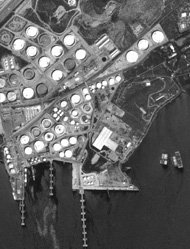![]()
12 July
The SPOT 5 satellite has successfully completed
in-orbit checkout. CNES has handed over responsibility for commercial operation
of the SPOT 5 system to Spot Image, which will now be distributing imagery
acquired by the new satellite worldwide:
· system availability is excellent;
· geometric and radiometric quality of images from the two HRG (high-resolution
geometric) instruments and the HRS (high-resolution stereoscopic) instrument
is excellent, exceeding specifications; indeed, ways of further enhancing
performance have already been identified.
In-orbit checkout of the VEGETATION instrument will be completed in November
2002. Performance of the VEGETATION and DORIS instruments so far is also excellent.
10 July
The SPOT 5 in-orbit checkout review was held this
Wednesday 10 July. Tests performed during in-orbit checkout have shown that:
· the satellite, ground telemetry and command systems, and passenger instruments
are functioning perfectly and system availability is excellent;
· geometric and radiometric quality of images from the two HRG (high-resolution
geometric) instruments and the HRS (high-resolution stereoscopic) instrument
is excellent, exceeding specifications; indeed, ways of further enhancing
performance have already been identified.
21 June 2002
All scheduled operations on the satellite bus have
been completed.
Focusing has been optimized on both imaging instruments.
Peformance assessments are ongoing and initial results are looking good.
The in-orbit checkout phase is scheduled to end on 10 July 2002.
3 June
On Monday 3 June, SPOT 5 took this picture of the ERS-2 satellite at about 23:00 UTC over the Southern Hemisphere. ERS-2, 42 kilometres below, overtakes SPOT 5 from north-east to south-west at a relative velocity of about 291 kilometres per hour.
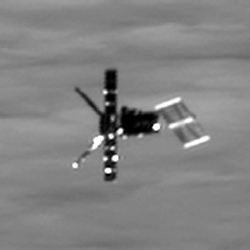
30 May
The SPOT 5 Satellite Positioning Review held on Thursday
30 May confirmed that the satellite and all ground segment components are
working well.
All system functions have been successfully activated during the first weeks
in orbit and initial calibrations have been completed.
The month of June will be devoted to fine-tuning performance and closely assessing
image quality.
The in-orbit checkout phase is scheduled to end mid-July.
15 May - First pair of stereoscopic images
A first digital elevation model was produced from a pair of stereoscopic images of Naples acquired by HRS.
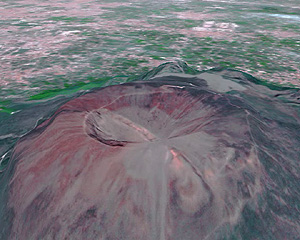
3D view of Mount Vesuvius (Italy)
3D animation of Naples and Mount Vesuvius
Normal speed with Naples and Mount Vesuvius MPEG
1 file (1,96 Moctets)
Full accelerated version MPEG 1 file MPEG
1 file 1820 Moctets
After a final manoeuvre, SPOT 5 has reached its final orbital position.
7 May - First image
SPOT 5 has just transmitted his first image : the city of Athens has been chosen. The quality of the data matches the expected technical specifications: a 2.5 m resolution image was produced using two 5 m resolution images from HRG instruments, processed according to the Supermode technique. Next images are now awaited !
6 May
Calibrations of the three instruments (HRG, HRS and VEGETATION) have been initiated.
4 May
On the fourth of May, SPOT 5 has been successfully launched
from Europe's spaceport in Kourou, French Guiana.
Solar pannels have been deployed. Satellite status is nominal.
SPOT 5 launch: video (MPEG1 1453 Kb)
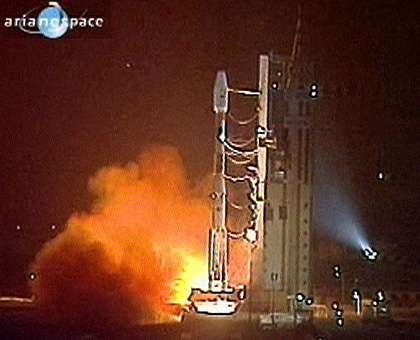
27 April
The fairing and satellite composite has been mated with the launch vehicle.
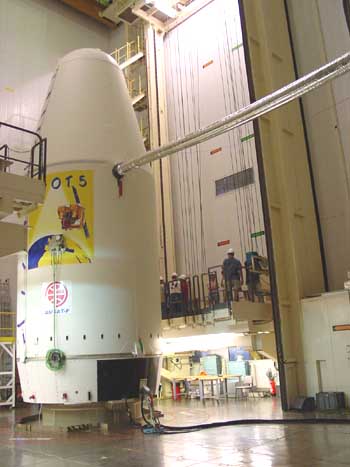
The composite mated with the launch vehicle
26 April
The satellite is encapsulated with the fairing.
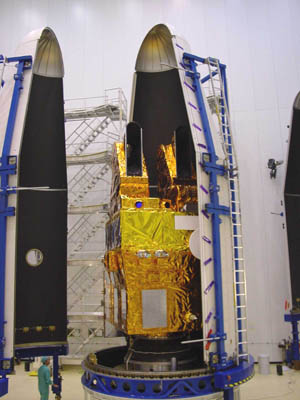
24 April
The satellite has been mounted on its adaptor and
will be encapsulated under the fairing tomorrow.
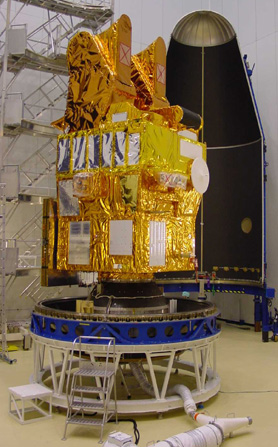
SPOT 5 on its launch adaptor
23 April
SPOT 5 is ready to be mounted on its launch adaptor, which provides the interface with the launch vehicle.
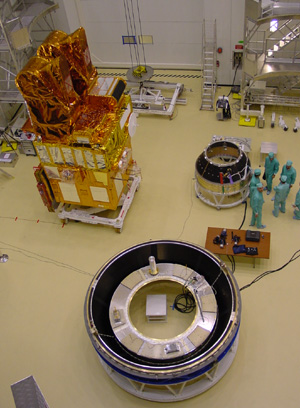
SPOT 5 on its launch adaptor
22 April
Launch vehicle rolled out to launch zone.
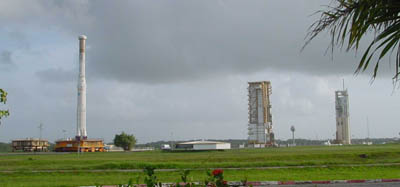
The launcher on its way to the launch pad
19 April
Fuelling and tank pressurization completed.
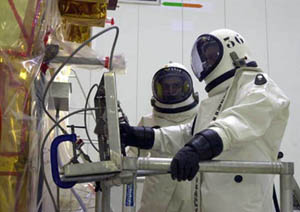
Fuelmen
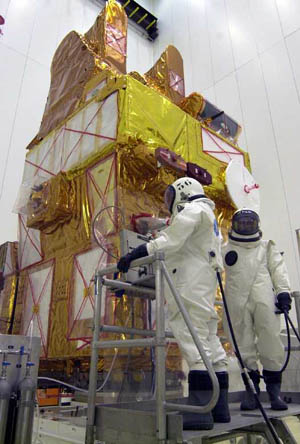
Fuelling
13 April
The satellite was moved from the integration hall for fuelling and encapsulation under the fairing before launch.
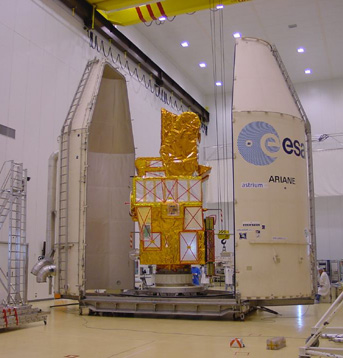
Arrival at S3
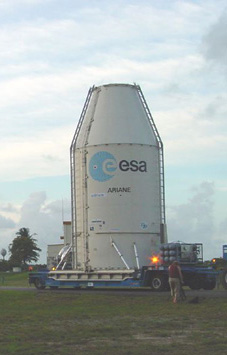
SPOT 5 in its shipping container between hall S1
and S3
11 April
The operational qualification review board
cleared the SPOT system to conduct launch, positioning and in-orbit checkout
operations.
10 April - Work on the satellite resumed at the Guiana Space Centre.
The key assets of SPOT 5 were presented
at a press conference at CNES headquarters. Particular emphasis was laid on
SPOT 5's unique combination of acquisition capability and 2.5-metre resolution.
The ability to produce wide-area digital elevation models efficiently thanks
to the new HRS instrument will round out the SPOT 5 offering.
22 March - satellite put
into storage
With the launch put back from 12 April to 3 May, the satellite was put into storage and the launch campaign put on hold. Preparations will resume on 12 April.
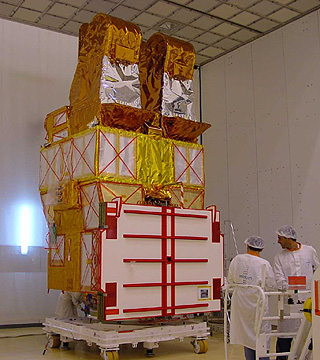
21 March - additional flight readiness review
Test results were reviewed and the satellite cleared for flight.
18 March -solar array integration completed
After electrical testing, leaktightness checks on the propulsion system and final alignment, the solar array was mounted on the satellite. Technicians are now putting the finishing touches to the thermal protection.
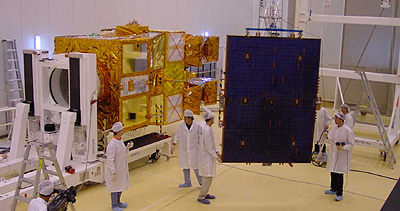
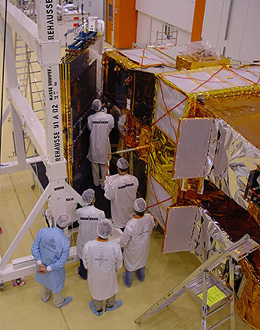
15 March - launch date announced
SPOT 5 is ready for launch from 12 April 2002. Arianespace
has currently scheduled the launch for 3 May.
12 March - Launch operations rehearsal
As part of the SPOT 5 system's operational qualification,
a full launch rehearsal was held in Toulouse from 12-15 March. The rehearsal
included a full test of launch and immediate post-launch operations.
7 March - Launch campaign
Launch preparations have gone according to plan since the satellite's arrival in Kourou. The bus was mated with the payload and the reaction wheels and solar array drive mechanism were secured in place.

SPOT 5 in Kourou on 7 March in propulsion test
configuration
21 February 2002 SPOT 5 departs from Toulouse, France, for French Guiana
SPOT 5 arrived in Cayenne on 21 February at 17:15 on the Airbus "Beluga" Super Transporter. The flight was a first for the world's largest freight aircraft, which was making its first stop in French Guiana and had never carried a whole satellite before.
SPOT 5 made the journey in two large containers (4.9 metres high, 7 metres long and 4.5 metres wide), one for the payload and another for the bus. The containers were loaded aboard the aircraft on the evening of Wednesday 20 February for a scheduled departure from Toulouse-Blagnac airport at dawn the next day. The 7,000-kilometre flight to French Guiana was made in two five-and-a-half-hour steps, with a short stopover near the halfway stage in the Cape Verde islands.
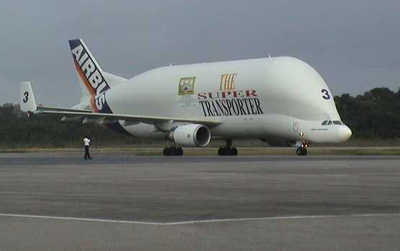
The Beluga arriving in Cayenne
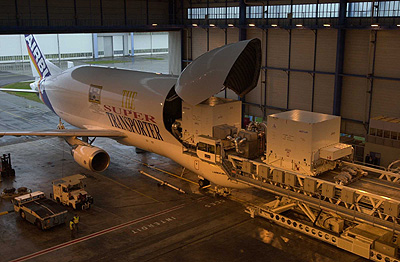
Loading SPOT 5 into the Beluga in Toulouse
27-28 November 2001 SPOT 5 seminar - Towards new applications
Pierre Baudis Conference Centre, Toulouse, France
The aim of this seminar was to present the results of the SPOT 5 Preparatory Programme.
The seminar highlighted the excellent balance that SPOT 5 offers between improved 2.5-metre resolution and a wide 60-kilometre imaging swath for a broad range of themes. Chief among these are mapping, farmland management and checking of agricultural areas, urban planning, forest management, natural disaster management, and telephone network planning and siting.
The ability of the new HRS instrument to support large-scale production of digital elevation models (DEMs) was also underlined as a key asset.
With 313 attendees from 14 countries, the seminar showed beyond doubt that potential users have great expectations for SPOT 5 data.
